
1/72 Caproni Ca.4
| KIT #: | |
| PRICE: | |
| DECALS: | None |
| REVIEWER: | Chris Peachment |
| NOTES: |
Lay in a vast store of strut. And 10 and 20 thou plastic card. And an extra spool of rigging thread. |

| HISTORY |
After designing the successful biplane bomber Ca.3, Gianni Caproni went on to a much bigger aircraft, which shared the same layout of the Ca.3, a twin boom configuration with a pusher engine at the rear of the cockpit nacelle, which hung below the central wing, with a forward gunner cockpit, and side by side seating for the two pilots. There were two engines at the front of the twin booms, which also had two gunner positions behind the wings, but which were often empty, presumably to save weight on long night missions. The twin booms carried a single elevator with triple fins. The landing gear had two sets of four wheels. The aircraft's framework was wood with fabric covering.
One early variation
had a central nacelle very similar to the Ca.3 and if anyone is mad enough to be
contemplating building this beast, that layout would be much simpler. Armament
was between four and
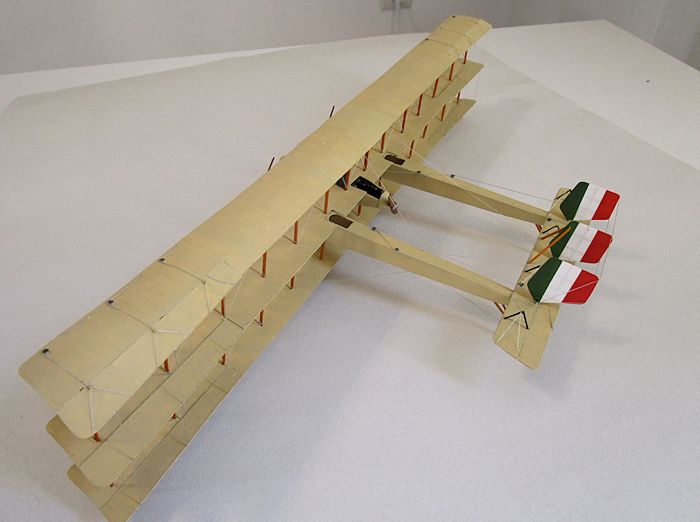 eight Revelli 6.5 mm machine guns. Bombs were carried in a
bomb canister, which was a long, narrow container fixed to a lower wing.
eight Revelli 6.5 mm machine guns. Bombs were carried in a
bomb canister, which was a long, narrow container fixed to a lower wing.
Ca.4s began operations in 1918 and attacked targets in Austria-Hungary. In April 1918, six Ca.4s were sold to Britain for the Royal Navy Air Service but were never used and were returned to Italy after the war.
The Ca.4 was well designed, fast, and had a bomb load surpassed only by the Zeppelin Staaken R.VI. But, alas, it was very fragile. Photographs of ones which have suffered a nose-over on landing show that it folded up like a cheap accordion.
After WWI there was an airliner version with a double-deck passenger cabin mounted between the booms which seated 23 passengers who entered via the nose. Sixteen sat in the lower cabin on benches along its walls with large windows, and the other seven passengers sat on an upper deck with the pilots, which must have been fun.
Disaster struck one on August, 1919 when it crashed near Verona killing the 17 people on board, the majority of whom were aviation writers. This did not do much for Caproni's PR and it sunk all hope of commercial airline development in Italy. In the wake of the disaster the government dissolved the General Directorate of Aeronautics. The inquiry discovered that the crash had been caused by a camera which had been dropped by a passenger, and had struck the central engine’s propeller and then been thrown against the tailplane, severing it.
It was Italy's first commercial aviation crash and one of the earliest heavier-than-air airliner disasters.
| CONSTRUCTION |
This whole mad
project came about after I received an email from a reader concerning one of my
earlier models. He asked if I had heard the rumour that Italeri were going to do
a Ca.3 biplane bomber. Strangely e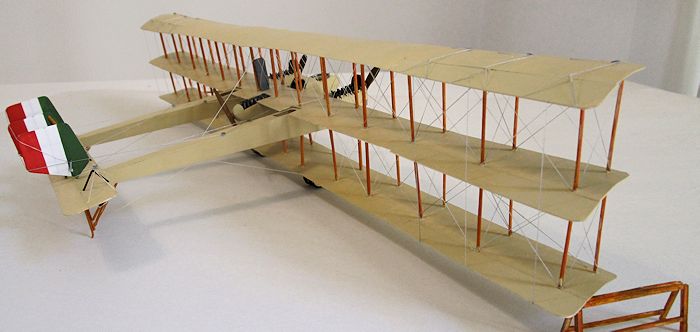 nough I had opened an Italeri catalogue about
5 years ago and saw that very model advertised as upcoming. But since then
nothing has appeared. The reader suggested that one sure-fire way to get a kit
released was to scratch build one first.
nough I had opened an Italeri catalogue about
5 years ago and saw that very model advertised as upcoming. But since then
nothing has appeared. The reader suggested that one sure-fire way to get a kit
released was to scratch build one first.
I can see a gauntlet when one is flung at my feet. And what can one do with a gauntlet but pick it up? I didn't have any plans for a Ca.3. But I did have a Windsock magazine for the Ca.4, which just happened to have an excellent set of plans. So, with a cry of “two wings good, three wings better,” I plunged in. Had I known what was coming, I might have given up modelling altogether and taken up something easier like bull fighting.
I had previously had to give up on the Roden model of the Zeppelin Staaken bomber. After wrestling with it for two years on and off, I finally had to admit defeat because the wings were moulded in one piece and were very heavy. Every attempt to put them together resulted in bent struts flying all over the place, and a decided anhedral, which was not part of Herr Zeppelin's original thinking. With this in mind, I realised that lightness was all, and so decided in advance to use only 10 thou card for the wings, which in any case were very thin on the original.
Each separate section of the aircraft was treated as a separate model in its own right. As a deal-breaker for the whole project I decided to make the cockpit nacelles first. If I got that right, then the rest would follow.
This did indeed
prove the trickiest part of the operation. I used an old engine nacelle from the
Zeppelin (scratch builder's maxim: throw nothing away), but it needed
considerable reshaping with filler. The twin-bump cowling for the two pilots was
the most difficult part, and had to be carved from solid plastic, and
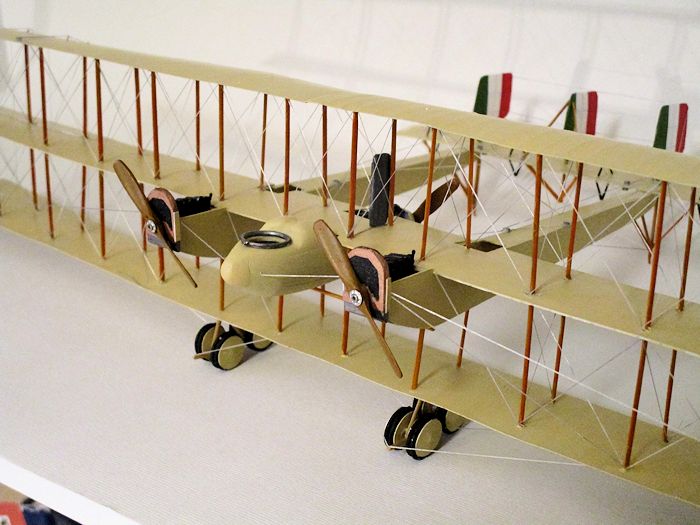 then
carefully shaped with a sponge sanding block. Once done, then I set to the wings
with a happy cry of “Do your worst”.
then
carefully shaped with a sponge sanding block. Once done, then I set to the wings
with a happy cry of “Do your worst”.
As with any scratch built model, the one thing which dogs the maker is alignment. That forest of struts was going to be the testing point for the whole project. So I decided to use one strut passing through the centre wing for both upper and lower wings. Since each strut was elliptical, making holes in the centre wing for them was difficult, but was accomplished by drilling a round hole, then tilting the drill backwards and forwards in line with the chord until each hole was oval. The strut was then passed through the centre wing, glued, and aligned very carefully while setting. All wings and struts were painted first, Vallejo buff for the linen and mid stone for the wood, followed by a coat of clear orange.
Once set, upper and lower wings were offered up and glued. I also rigged the outer cells at this stage, but left the centre cells clear for the cockpit and booms.
Rigging, as usual, was elastic thread, coloured silver with a felt tip pen, and held in place with superglue gel applied with a sharpened toothpick.
The booms were easy, just a long box of 20 thou card, with openings for the rear gunners. The engines are straight sixes from the spares box, and whilst I cannot guarantee they are the Fiat or Isotta Fraschini originals, they are hidden well enough so that only the cylinder heads are visible. The six exhaust pipes on each were added from bent rod, then duly knocked off while handling and so reserved until the last stages.
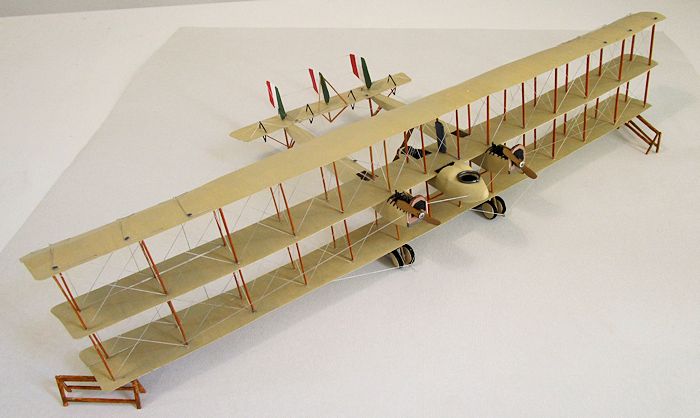 The front radiators
were cut from 40 thou card, with the cooling grille area scored with a scalpel,
and the surrounds painted copper. Holes were also drilled for the propellers.
The rear engine had a radiator with looks like a pool cue case, which I made
from a block of 40 thou card, with rounded edges and a couple of shutters closed
at the front. It was a medium grey.
The front radiators
were cut from 40 thou card, with the cooling grille area scored with a scalpel,
and the surrounds painted copper. Holes were also drilled for the propellers.
The rear engine had a radiator with looks like a pool cue case, which I made
from a block of 40 thou card, with rounded edges and a couple of shutters closed
at the front. It was a medium grey.
The fins were 10 thou card wrapped around a vertical rod, and painted that alluring Italian tricolour of red white and green. They were sunk through holes in the tailplane just ahead of the elevator, and then the pyramidical supports added from black rod. The two skids are attached to the lower part of each fin strut. Once all set, it can be elaborately rigged as seen. It was so large it almost resembled a small aircraft in its own right.
The cockpit nacelle had two large fuel tanks, cut from old thick sprue, which also functioned on the original as back rests for the pilots. Think about that for a moment. You are performing a long range bombing mission, which presumably comes up against the usual resistance from fighters and flak, and you are sitting on a seat whose back rest is the fuel tank, which in those days would not be self-sealing. Just thinking about it brings me out in a sweat.
Two seat buckets were glued on mounts ahead of the tanks and a couple of control wheels mounted on a pair of rods. The front gunner's position was rounded out with a rat tailed file. The whole nacelle was then glued under the central wing.
Both booms were offered up and glued. The massive beast was turned over on its back to have the undercarriage struts glued on. Wheels were made up from solder wrapped around a paint brush handle, with discs cut from 10 thou card with a circle cutter, and dished with a chisel handle. They were superglued to the axles, and once it was all dry, the giant was gingerly lowered onto the ground. By the good grace of the patron Saint of Aviation (Saint Joseph of Cupertino, since you ask), it sat four square on its wheels and two tail skids, without a hint of daylight showing under any of them.
 It was now that the
fun began. Of course it sat four square on its wheels and skids, because
everything had become so heavy that it forced the booms and wings out of
alignment just so that it could sink to the ground with relief. The whole thing
looked like it had been kicked aslant by a heavy boot on one wingtip and the
struts, all so carefully arranged to be in alignment were now twanging all over
the place, like a night out at the disco.
It was now that the
fun began. Of course it sat four square on its wheels and skids, because
everything had become so heavy that it forced the booms and wings out of
alignment just so that it could sink to the ground with relief. The whole thing
looked like it had been kicked aslant by a heavy boot on one wingtip and the
struts, all so carefully arranged to be in alignment were now twanging all over
the place, like a night out at the disco.
Saint Joseph had not been doing his stuff, but then he is also the patron saint of those with a mental handicap, which rang a bell in this house.
Very carefully, I trimmed one tail skid and then the other slightly more, and began to twist the booms. After much grunting, it eventually evened up, but it was touch and go. It was then that the wings took a turn for the worse. The wrenching around had produced undulations in the trailing edges. Calling down curses from heaven on St Joseph, I attached clothes pegs at the wavy parts, and allowed the weight to bend them back into shape. Judicious application of heat from a hair dryer then helped to re-set the plastic. Keep your distance however or the whole thing will melt into a heap.
Adding three ailerons on each side and then rigging them with elastic thread then caused more warping. In retrospect it would have been better to have incorporated them solid with each wing, and just scored the joint line. Eventually I had to make a pair of trestles which fitted loosely under each wing tip to alleviate the wing droop.
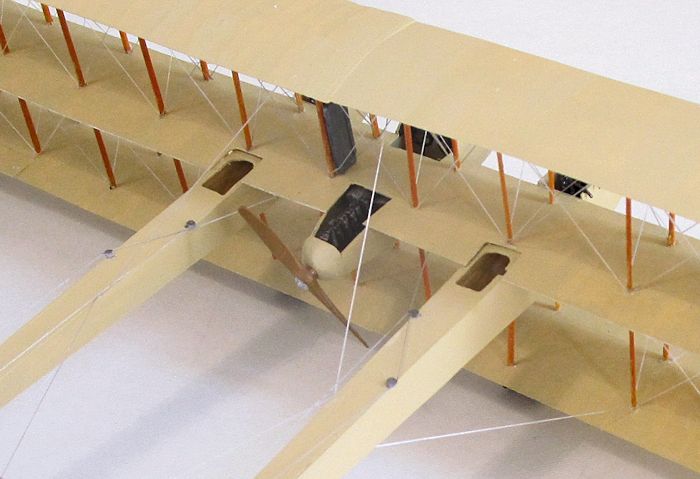 The only way to
photograph this whopping great thing was to zoom the lens right out, and stand
close. This has had the distorting effect of making one or two of the struts
look misaligned, which is annoying, although I can attest that they all conform
to a perfect four square pattern. If they had not, rest assured I would have
kicked the wretched thing to pieces, buried it, dug it up again and set fire to
it.
The only way to
photograph this whopping great thing was to zoom the lens right out, and stand
close. This has had the distorting effect of making one or two of the struts
look misaligned, which is annoying, although I can attest that they all conform
to a perfect four square pattern. If they had not, rest assured I would have
kicked the wretched thing to pieces, buried it, dug it up again and set fire to
it.
The control lines were added as the final touch. Small pulleys were made from end-cuts of rod, and placed on the upper and lower wings and also the tail booms. Control lines were then easy to rig. Finally there were one or two more lines from the nacelle out to the wings, and also to the undercarriage.
I didn't build the bomb carrier because it was an ungainly looking contraption, rather like a suitcase which has shut itself around the lower wing. I didn't add machine guns either because I am becoming more and more pacific with age and don't like things that go bang.
| CONCLUSIONS |
What do you do after you have climbed Everest? What do you do after you have killed a Miura bull with a perfect estocada? What do you do after bringing Covent Garden opera house to its feet with your rendition of Don Giovanni?
Unacquainted with any of those little hobbies, I have no idea, so I sat back with a happy sigh, which was seven tenths relief, and had an espresso and a cigarette. Like Jesus' love, an espresso and a cigarette never fails me. And wondered what to do next. I think it will be a monoplane with few parts.
| REFERENCES |
Windsock Datafile number 111. I heartily recommend any of these magazines, which provide a definitive text, many period photographs and excellent scale drawings, in this case by Martin Digmayer.
http://www.aer.ita.br/~bmattos/mundo/bomb/caproni4.htm
http://stephenesherman.com/caproni-ca4-series/
http://flyingmachines.ru/Site2/Crafts/Craft25518.htm
November 2015
Copyright ModelingMadness.com
If you would like your product reviewed fairly and fairly quickly, please contact the editor or see other details in the Note to Contributors.